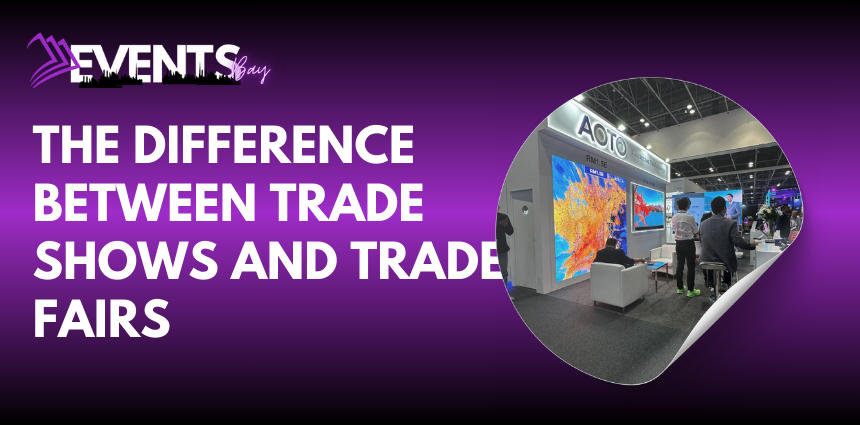Trade shows and trade fairs are often used interchangeably, but they are distinct events with specific purposes and characteristics. Understanding these differences can help businesses make informed decisions about which type of event best suits their needs for marketing, networking, and industry engagement. In this blog, we’ll explore the key differences between trade shows and trade fairs, examining their objectives, formats, and benefits to help you navigate these important business events.
What is a Trade Show?
A trade show is a specialized event where companies within a particular industry come together to showcase their products, services, and innovations. These events are often organized around specific sectors or industries, such as technology, healthcare, or automotive. Here are some defining features of trade shows:
Focused Industry Engagement
Trade shows are typically focused on a single industry or niche, attracting professionals, manufacturers, suppliers, and buyers within that sector. This concentration allows for targeted networking and marketing opportunities, as attendees are specifically interested in the products and services related to their field.
Product Demonstrations and Innovations
One of the primary purposes of a trade show is to showcase new products, technologies, and innovations. Companies use these events to demonstrate their latest offerings, providing live demonstrations and hands-on experiences for attendees. This focus on innovation makes trade shows ideal for companies looking to highlight their advancements and differentiate themselves from competitors.
B2B Focus
Trade shows are predominantly business-to-business (B2B) events, where the primary audience consists of industry professionals, decision-makers, and buyers. Exhibitors aim to generate leads, build relationships with potential clients, and explore new business opportunities. The B2B nature of trade shows means that the interactions are often more focused on forming business partnerships and making sales.
Strategic Networking Opportunities
Networking is a crucial aspect of trade shows. The event provides ample opportunities for attendees and exhibitors to connect, share knowledge, and explore collaborations. Networking at trade shows can lead to valuable partnerships, client acquisitions, and industry insights that contribute to business growth and development.
What is a Trade Fair?
Trade fairs, while similar to trade shows, have a broader focus and can encompass various industries and sectors within a single event. Here’s what distinguishes trade fairs from trade shows:
Broader Industry Scope
Trade fairs are designed to cover a wide range of industries and sectors. These events often feature multiple sectors within a single fair, making them more diverse in terms of exhibitors and attendees. For example, a trade fair might include sections for automotive, electronics, fashion, and food industries, attracting a more varied audience.
General Consumer and Business Audience
Unlike trade shows, which are primarily B2B, trade fairs often attract both business and consumer audiences. This broader focus means that trade fairs are designed to appeal to a wider range of attendees, including individual consumers who are interested in exploring different products and services.
Focus on General Awareness and Engagement
Trade fairs often emphasize general awareness and engagement rather than specific product demonstrations. Exhibitors at trade fairs may showcase their offerings to a broader audience, aiming to build brand recognition and attract potential customers rather than solely focusing on business transactions.
Diverse Exhibitor Participation
Trade fairs typically feature a diverse array of exhibitors from various industries. This diversity allows for a more comprehensive exploration of different sectors within the same event. Exhibitors at trade fairs may include manufacturers, service providers, retailers, and other entities looking to reach a broad audience.
Key Differences Between Trade Shows and Trade Fairs
1. Industry Focus
- Trade Shows: Focused on a specific industry or sector.
- Trade Fairs: Cover multiple industries and sectors within a single event.
2. Audience Type
- Trade Shows: Predominantly B2B, targeting industry professionals, decision-makers, and buyers.
- Trade Fairs: Attract both business and consumer audiences, with a broader appeal.
3. Purpose and Goals
- Trade Shows: Emphasize showcasing new products, technologies, and innovations, with a focus on business development and lead generation.
- Trade Fairs: Focus on general awareness, brand recognition, and engaging a diverse audience.
4. Networking Opportunities
- Trade Shows: Provide targeted networking opportunities within a specific industry.
- Trade Fairs: Offer a broader networking experience with a diverse range of participants.
5. Exhibitor Diversity
- Trade Shows: Exhibitors are typically concentrated within a particular industry.
- Trade Fairs: Feature a diverse array of exhibitors from various sectors.
Professional Booth Design and Construction for Trade Events
For trade events, professional booth design and construction are crucial for making a lasting impression and achieving your marketing objectives. StandsBay, an expert exhibition stands builder and booth contractor, excels in delivering high-quality, custom-designed booths tailored to showcase your brand effectively. As a leading exhibition stands company, StandsBay provides comprehensive solutions that include innovative design, precise construction, and meticulous attention to detail. Their expertise ensures that each booth not only stands out visually but also enhances your trade event presence, engages visitors, and drives business success. With StandsBay’s professional booth design and construction services, you can be confident that your trade event participation will be impactful and memorable.

